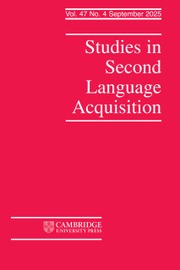Article contents
FUNDAMENTAL AND GRADIENT DIFFERENCES IN LANGUAGE DEVELOPMENT
Published online by Cambridge University Press: 01 June 2009
Abstract
This article reexamines Bley-Vroman’s original (1990) and evolved (this issue) fundamental difference hypothesis that argues that differences in path and endstate of first language acquisition and adult foreign language learning result from differences in the acquisition procedure (i.e., language faculty and cognitive strategies, respectively). The evolved assessment of the theoretical and empirical developments of the past 20 years is taken into account with respect to Universal Grammar and parameters in generative theory and with respect to cognition and acquisition in data processing. This article supports the spirit of Bley-Vroman’s proposals in light of the discussion of three topics: pathway of acquisition, endstate age of acquisition effects, and language processing by monolinguals and bilinguals. I argue that the difference between child and adult language acquisition is, above all, quantitative not qualitative, a gradient continuum rather than a precipitous break.
- Type
- Research Articles
- Information
- Studies in Second Language Acquisition , Volume 31 , Special Issue 2: THE FUNDAMENTAL DIFFERENCE HYPOTHESIS TWENTY YEARS LATER , June 2009 , pp. 259 - 289
- Copyright
- Copyright © Cambridge University Press 2009
References
REFERENCES
- 14
- Cited by


